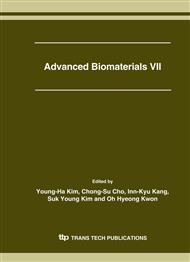p.269
p.273
p.277
p.281
p.285
p.289
p.293
p.297
p.301
Investigation of Pore Size Effect on Cell Compatibility Using Pore Size Gradient Chitosan Scaffold
Abstract:
Chitosan cylindrical scaffolds with gradually increasing pore size along the longitudinal direction were fabricated by a novel centrifugation method to investigate pore size effect on cell interactions. The scaffold was fabricated by the centrifugation of a cylindrical mold containing fibril-like chitosans. The pore size ranges of the scaffold could be controlled by adjusting the centrifugal speed: the scaffold with gradually increasing pore size (from ~80 #m to ~400 #m) and porosity (from ~82 % to ~93 %) along the cylindrical axis was obtained by applying the centrifugal speed, 3,000 rpm. The scaffold sections were examined for their in vitro cell interactions using different kinds of cells (fibroblasts, chondrocytes, and osteoblasts) in terms of scaffold pore sizes. It was observed that different kinds of cells were shown to have different pore size ranges in the scaffold for effective cell growth. The chitosan scaffold section with ~400 #m pore size showed better cell growth for chondrocytes and osteoblasts, while the scaffold section with ~190 #m pore size was better for fibroblast growth. The pore size gradient scaffolds fabricated by the centrifugation method can be a good tool for the systematic studies of the interactions between cells or tissues and scaffolds with different pore size.
Info:
Periodical:
Pages:
285-288
Citation:
Online since:
July 2007
Authors:
Keywords:
Price:
Сopyright:
© 2007 Trans Tech Publications Ltd. All Rights Reserved
Share:
Citation:


